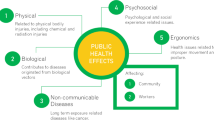Abstract
Recycling is time consuming and the time available for housework may determine the intensity of recycling activities. In this study, we conducted a survey of 546 Japanese households and asked them their daily practice of five varieties of recycling activities: (1) choice of refill products, (2) use of own shopping bags, (3) sorting of recycled papers from burnable waste, (4) use of own drinking bottles when going out, and (5) use of recycle boxes prepared at the grocery store. We also asked households to record their behavior for two successive days. By combining recycling activity data and diary data, we estimate a multivariate probit model to empirically examine whether time available for housework determines the intensity of five varieties of recycling activities. The empirical result demonstrates that an individual that can allocate sufficient time for housework tends to purchase refill products. He or she also tends to bring their own shopping bags for grocery shopping. We also find that the size of house and the number of family members determine the likelihood of recycling. A housewife living with many family members in a large house is more likely to engage in time-consuming recycling activities.
Similar content being viewed by others
Notes
Bruvoll et al. [2] investigated the recycling efforts of households and found that an average household spent approximately half an hour per week in cleaning, sorting, and transporting recyclable waste.
Following the reviewer’s advice, we conducted the robustness check in this section. We would like to thank the referee for giving constructive comments.
We obtained the minus sign for recycle box use. This result might suggest that people are using a recycle box on their commuting path.
References
Japan Container and Package Recycling Association (2007) Study the basic of Container Package Recycling Law. http://www.jcpra.or.jp/consumer/what/tabid/ 173/index.php Accessed 8 Aug 2017 (In Japanese)
Bruvoll A, Halvorsen B, Nyborg K (2002) Households’ recycling efforts. Resour Conserv Recycl 36:337–354. https://doi.org/10.1016/S0921-3449(02)00055-1
Matsumoto S (2011) Waste separation at home: is the municipal curbside recycling policy efficient? Resour Conserv Recycl 55:325–334. https://doi.org/10.1016/j.resconrec.2010.10.005
Morris GE, Holthausen DM (1994) The economics of household solid waste generation and disposal. J Environ Econ Manag 26:215–234. https://doi.org/10.1006/jeem.1994.1014
Jakus PM, Tiller KH, Park WM (1996) Generation of recyclables by rural households. J Agric Resour Econ 21:96–108
Bruvoll A, Nyborg K (2004) The cold shiver of not giving enough: on the social cost of recycling campaigns. Land Econ 80:539–549. https://doi.org/10.2307/3655809
Ando AW, Gosselin AY (2005) Recycling in multifamily dwellings: does convenience matter? Econ Inq 43:426–438. https://doi.org/10.1093/ei/cbi029
Berglund C (2006) The assessment of households’ recycling costs: the role of personal motives. Ecol Econ 56:560–569. https://doi.org/10.1016/j.ecolecon.2005.03.005
Halvorsen B (2008) Effects of norms and opportunity cost of time on household recycling. Land Econ 84:501–516. https://doi.org/10.3368/le.84.3.501
Matsumoto S (2014) The opportunity cost of pro-environmental activities: spending time to promote the environment or earning more money? J Fam Econ Issue 35:119–130. https://doi.org/10.1007/s10834-013-9354-3
Matsumoto S (2014) Spouses’ time allocation to pro-environmental activities: who is saving the environment at home? Rev Econ Househ 12:159–176. https://doi.org/10.1007/s11150-013-9177-x
Andreoni J (1990) Impure altruism and donations to public goods: a theory of warm-glow giving. Econ J 100:467–477. https://doi.org/10.2307/2234133
Matsumoto S (2017) Environmental burden of household sector and pro-environmental behavior. Chapter 2. In: Arimura TH, Katayama H, Matsumoto S (eds) Frontier of environmental economics. Nippon Hyoronsha, pp 99–123. ISBN-10: 4535558574 (In Japanese).
Saphores J-DM, Nixon H, Ogunseitan OA, Shapiro AA (2006) Household willingness to recycle electronic waste: an application to California. Environ Behav 38:183–208. https://doi.org/10.1177/0013916505279045
Meneses GD, Palacio AB (2005) Recycling behavior: a multidimensional approach. Environ Behav 37:837–860. https://doi.org/10.1177/0013916505276742
Ministry of Health, Labour and Welfare (2016) Basic survey on wage structure. https://www.mhlw.go.jp/toukei/list/chinginkouzou.html. Accessed 15 Oct 2017 (In Japanese)
Sidique SF, Lupi F, Joshi SV (2010) The effects of behavior and attitudes on drop-off recycling activities. Resour Conserv Recycl 54:163–170. https://doi.org/10.1016/j.resconrec.2009.07.012
Scott D (1999) Equal opportunity unequal results: determinants of household recycling intensity. Environ Behav 31:267–290. https://doi.org/10.1177/00139169921972100
Brekke KA, Kverndokk S, Nyborg K (2003) An economic model of moral motivation. J Public Econ 87:1967–1983. https://doi.org/10.1016/S0047-2727(01)00222-5
Brown E, Lankford H (1992) Gifts of money and gifts of time: estimating the effects of tax prices and available time. J Public Econ 47:321–341. https://doi.org/10.1016/0047-2727(92)90032-B
Carlin PS (2001) Evidence on the volunteer labor supply of married women. South J Econ 67:801–824. https://doi.org/10.2307/1061572
Acknowledgements
The author received financial support from the Institute of Economic Research of Aoyama Gakuin University and from the Japan Society for the Promotion of Science KAKENHI (Grant number: 26340119). An earlier version of this paper was presented at the 2018 International Symposium on Economics and Social Science hold at Sapporo, Japan. I thank the symposium participants.
Author information
Authors and Affiliations
Corresponding author
Rights and permissions
About this article
Cite this article
Matsumoto, S. Time allocation and recycling activities. J Mater Cycles Waste Manag 20, 2062–2067 (2018). https://doi.org/10.1007/s10163-018-0759-9
Received:
Accepted:
Published:
Issue Date:
DOI: https://doi.org/10.1007/s10163-018-0759-9




